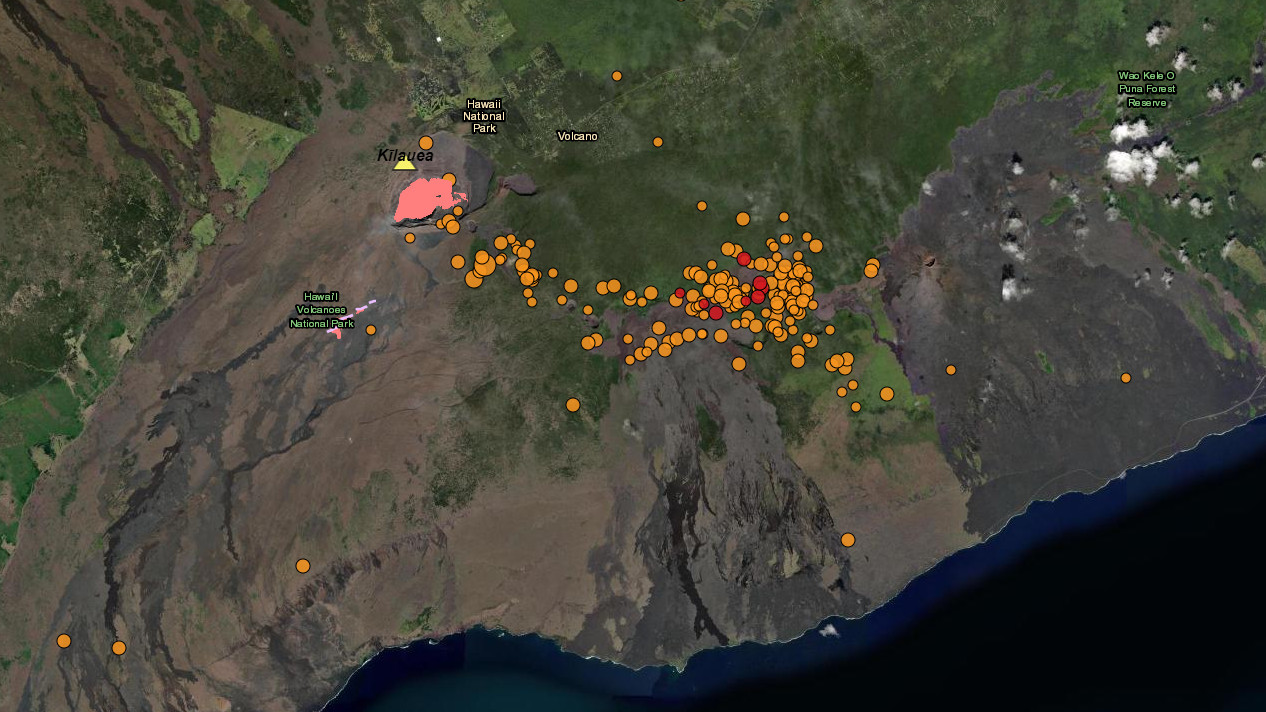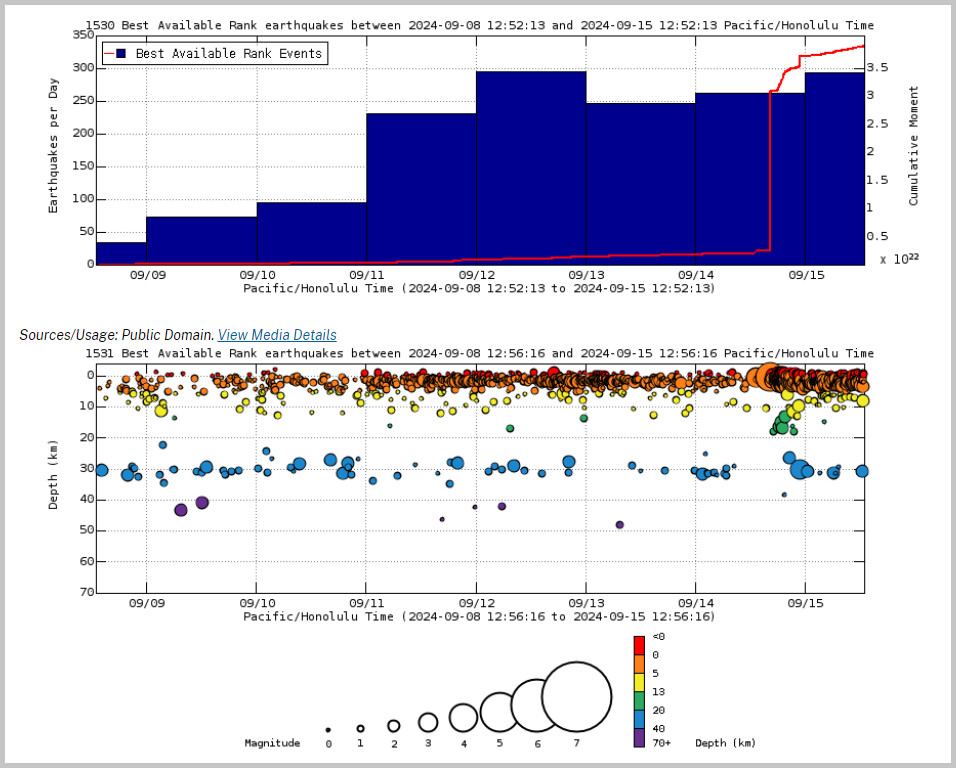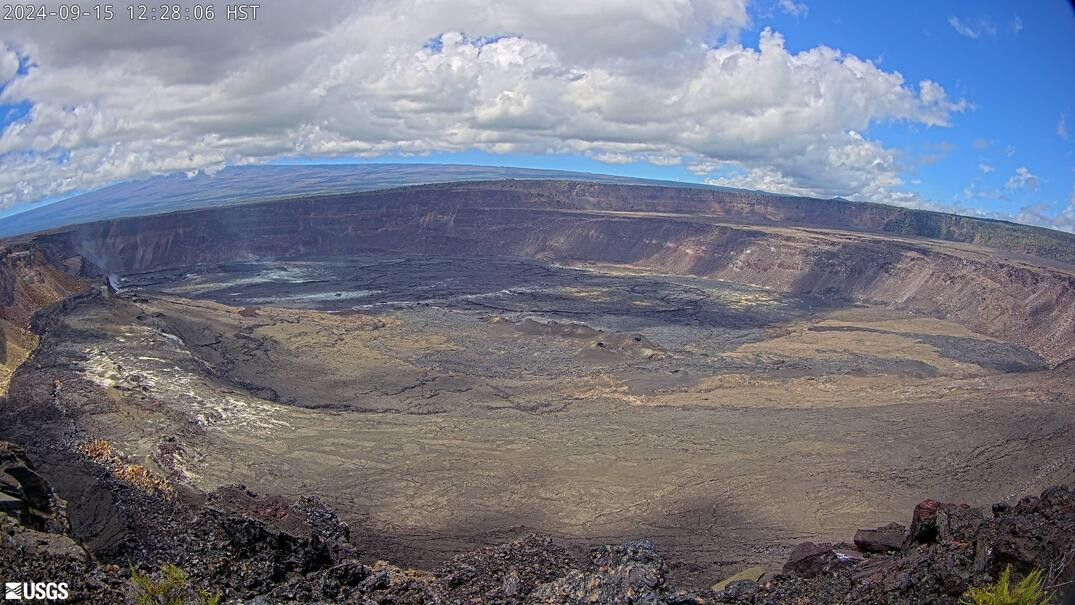
image from an interactive USGS map showing the location of the most recent earthquakes on Kīlauea’s upper and middle East Rift Zone.
(BIVN) – Kīlauea is not erupting, although seismicity and deformation in the middle East Rift Zone increased dramatically at 6 p.m. Saturday evening.
The USGS Volcano Alert Level for Kīlauea remains at ADVISORY. Scientists reported the new activity has continued to decrease in intensity overnight, but continued at lower levels Sunday morning.
The earthquakes and deformation are located northwest of Makaopuhi Crater “indicating intrusion of magma beneath this area,” the USGS Hawaiian Volcano Observatory stated on Sunday. “The current intrusive activity represents the furthest eastward shallow intrusive activity with deeper activity occurring between Makaopuhi Crater and Puʻuʻōʻō during the past month.”
From the USGS HVO update posted at 8 a.m. HST:
Summit Observations: Seismometers detected 40 earthquakes beneath Kīlauea’s broader summit region over the past day, including a magnitude 4.3 earthquake at 4:25 p.m. yesterday, September 14. Most were at depths between 1 km – 3 km (0.6 mi – 1.9 mi) below the surface. The Uēkahuna tiltmeter at the summit began recording significant deflation around 7 p.m. yesterday, about an hour after the seismic swarm began in the middle East Rift Zone yesterday. By this morning, the tiltmeter recorded about 7 microradians of deflation related to the middle East Rift zone event.The most recent measurement of SO2 emission rate was 75 tonnes per day on August 20, 2024.

Above Top: Number of earthquakes per day during the past week (blue bars). The red line is the cumulative moment (energy) release. Bottom: Depth of earthquakes during the past week in the area shown on the map above. Depth is reported relative to sea level, which is equal to a depth of zero on the above plot. On both figures, circle-size represents magnitude, and color indicates depth. (USGS graphs)
Rift Zone Observations: Just after 6 p.m. yesterday (September 14) a seismic swarm began in the middle East Rift Zone (MERZ) accompanied by inflationary tilt recorded on the Escape Road (ESC) and Puʻuʻōʻō cone (POC) tiltmeters (Kīlauea Status Report — Middle East Rift Zone Unrest | U.S. Geological Survey (usgs.gov)). The combined seismicity and deformation patterns suggest that a dike was emplaced in the region just northwest of Makaopuhi Crater where an Interferometric SAR (InSAR) image spanning from August 28 to September 12, had identified uplift. There have been 280 earthquakes recorded in this area in the last 24 hours, with most occurring since 6 p.m. last night when activity peaked at 30 earthquakes per hour. By this morning, the size of earthquakes has decreased, but pulses of up to 25 earthquakes per hour continue. Local deformation recorded at the ESC and POC tiltmeters slowed significantly by 4 a.m. this morning with little deformation recorded since then.
Activity in other parts of the East Rift Zone to the east or downrift of Puʻuʻōʻō (the site of 1983–2018 eruptive activity) remains low. GPS instruments have recorded periods of inflation in portions of the middle East Rift Zone (MERZ) uprift of Puʻuʻōʻō during the past month. Measurements from continuous gas monitoring stations downwind of Puʻuʻōʻō in the MERZ remain below detection limits for SO2, indicating that SO2 emissions from this area are negligible.
Analysis: The current MERZ intrusion and unrest indicates that magma continues to be supplied to this area in multiple localities. This event follows an intrusive event that occurred near Pauahi Crater over July 22–25, 2024, and another intrusive event happened near the same vicinity on August 20, 2024. The current intrusive activity represents the furthest eastward shallow intrusive activity with deeper activity occurring between Makaopuhi Crater and Puʻuʻōʻō during the past month. Shallow intrusions like this event could lead to a short-lived eruption, but historically eruptions make up only about 10% of the events recorded in this region. While the current activity has decreased since yesterday, renewed or new activity remains possible and may evolve quickly.


by Big Island Video News1:14 pm
on at
STORY SUMMARY
HAWAIʻI ISLAND - Volcanic unrest continues on Kīlauea volcano's middle East Rift Zone, as a swarm of earthquakes indicates another magma intrusion in the area.